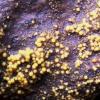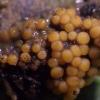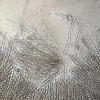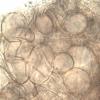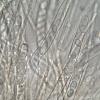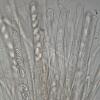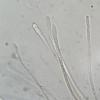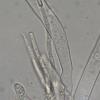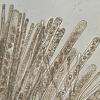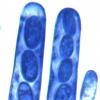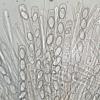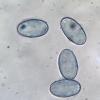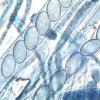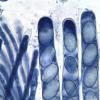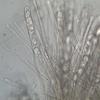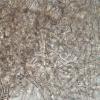
06-12-2025 00:19
 Viktorie Halasu
Viktorie Halasu
Hello, would anyone have this article, please? An

05-12-2025 17:33
 Bruno Coué
Bruno Coué
Bonjour, je serais heureux de recueillir votre avi

02-12-2025 18:59
This pair of ascos 2.5cm across were on recently b

02-12-2025 19:25
Buckwheat PeteHello, can anyone identify this hairy fungus growi

30-11-2025 12:53
 Edvin Johannesen
Edvin Johannesen
White short-stipitate apothecia found on thin twig

30-11-2025 10:47
 William Slosse
William Slosse
I recently found a collection of small Peziza sp.
Asco on dung
Lepista Zacarias,
14-02-2017 20:23
I would like to have your help to identify this asco, growing on dung (probably of dog). It consist of small yellow round balls (up to 1 mm). Initially, due to youth, I could only see paraphyses and very few small asci. After 4 days in the fridge, the asci are now abundant, but maybe not yet completely mature, since no free spores were observed. Anyhow, I measured them and got:
(12.2) 13.1 - 14.5 (15.8) × (6.7) 6.8 - 7.7 (8.2) µm
Q = (1.7) 1.8 - 2 (2.2) ; N = 36
Me = 13.7 × 7.2 µm ; Qe = 1.9
All parts are I-. After I used melzer with the same result.
I upload some photos of the specimens and of the corresponding microscopy. I have created an obsevation where more details can be found:
http://mushroomobserver.org/269546
Thanks in advance,
zaca
Peter Püwert,
14-02-2017 21:46
Re : Asco on dung
Hi L. Z.,
this looks like immature Cheilymenia. I don't like dung of dog, cat and homo sapiens, and then still in the fridge ?
Greetings Peter.
this looks like immature Cheilymenia. I don't like dung of dog, cat and homo sapiens, and then still in the fridge ?
Greetings Peter.
Lepista Zacarias,
14-02-2017 21:59
Re : Asco on dung
Thanks Peter,
for your response. I also don't like many things, including those you mentioned and many more.
The sample will be in the fridge, to mature, and possibly to identify it.
Regards,
zaca
for your response. I also don't like many things, including those you mentioned and many more.
The sample will be in the fridge, to mature, and possibly to identify it.
Regards,
zaca
Peter Püwert,
14-02-2017 22:07
Re : Asco on dung
Hi Zaca,
in the fridge it could be, possibly, too coldly for the development, divide perhaps the collection.
Greetings Peter.
in the fridge it could be, possibly, too coldly for the development, divide perhaps the collection.
Greetings Peter.
Lepista Zacarias,
14-02-2017 22:10
Re : Asco on dung
Good suggestion,
I will act accordingly.
Thanks again, Peter.
Regards,
zaca
I will act accordingly.
Thanks again, Peter.
Regards,
zaca
Lepista Zacarias,
16-02-2017 22:21
Re : Asco on dung
After two more days in the fridge, I made another microscopic observation. Again no free spores were seen, but the spores are now MUCH more mature and bigger with
(14) 14.7 - 18.1 (19.6) × (8.1) 8.7 - 10.4 (11.3) µm
Q = (1.6) 1.7 - 1.87 (1.9) ; N = 34
Me = 16.8 × 9.5 µm ; Qe = 1.8
I used the following reference
Keys to Fungi on Dung: M.J. Richardson, Roy Watling, The British Mycological Society, 1997;
Tacking into account the lack of hairs at the margin (some rudimentary and hialine exist at the botoom of the ascocarp) and supposing that the colour of the ascocarps is "orange" (in fact, some orangish tones are present, though the dominant coloration is yellow) one gets
Cheilymenia granulata (as Coprobia granulata).
I have seen the webpage
http://guiahongosnavarra1garciabona.blogspot.pt/search/label/Cheilymenia%20granulata
and, though the photos illustrate mature specimens with flat apothecia, the micro features are very similar to mine.
So, is this the end of the story? or ..
Attached I upload a photo of the last microscopy.
Regards, zaca
(14) 14.7 - 18.1 (19.6) × (8.1) 8.7 - 10.4 (11.3) µm
Q = (1.6) 1.7 - 1.87 (1.9) ; N = 34
Me = 16.8 × 9.5 µm ; Qe = 1.8
I used the following reference
Keys to Fungi on Dung: M.J. Richardson, Roy Watling, The British Mycological Society, 1997;
Tacking into account the lack of hairs at the margin (some rudimentary and hialine exist at the botoom of the ascocarp) and supposing that the colour of the ascocarps is "orange" (in fact, some orangish tones are present, though the dominant coloration is yellow) one gets
Cheilymenia granulata (as Coprobia granulata).
I have seen the webpage
http://guiahongosnavarra1garciabona.blogspot.pt/search/label/Cheilymenia%20granulata
and, though the photos illustrate mature specimens with flat apothecia, the micro features are very similar to mine.
So, is this the end of the story? or ..
Attached I upload a photo of the last microscopy.
Regards, zaca
Nicolas VAN VOOREN,
17-02-2017 18:00

Re : Asco on dung
A view of free ascospores in CB is required to see the spore ornamentation, this is the only way to try a determination.
Ch. granulata possesses wide paraphyses containing granules of a orange pigment, but there exists other Cheilymenia with rudimentary hairs.
Ch. granulata possesses wide paraphyses containing granules of a orange pigment, but there exists other Cheilymenia with rudimentary hairs.
Lepista Zacarias,
18-02-2017 01:29
Michel Delpont,
18-02-2017 09:44

Re : Asco on dung
The first photo shows fine streaks on the spores and one could then head towards the genus Coprobia; But could you also measure the width of the paraphyses and their vertices?
Michel.
Michel.
Gilbert MOYNE,
18-02-2017 10:04
Re : Asco on dung
Voir peut-être du côté de Cheilymenia granulata var. sordida qui ne présente pas des sommets de paraphyses trè élargis
Gilbert
Gilbert
Lepista Zacarias,
18-02-2017 10:15
Re : Asco on dung
Merci, Michel.
I got the following dimension for the width of the paraphyses:
3.3 - 3.9 um at the base of the photo
5.4 - 6.8 um at the tips.
Best regards,
zaca
I got the following dimension for the width of the paraphyses:
3.3 - 3.9 um at the base of the photo
5.4 - 6.8 um at the tips.
Best regards,
zaca
Lepista Zacarias,
18-02-2017 10:41
Re : Asco on dung
Thanks, Gilbert, for your comment.
I saw that the variety you mentioned (sordida) has paraphyses similar to this specimen.
Best regards,
zaca
I saw that the variety you mentioned (sordida) has paraphyses similar to this specimen.
Best regards,
zaca
Nicolas VAN VOOREN,
18-02-2017 10:51

Re : Asco on dung
Oui, je pense qu'il faut s'orienter vers sordida.
Michel Delpont,
18-02-2017 14:05

Re : Asco on dung
Ok aussi pour sordida; ça semble bien correspondre!
Michel.
Michel.
Lepista Zacarias,
19-02-2017 19:20
Re : Asco on dung
Thank you all, Peter, Nicolas, Michel and Gilbert.
I think that, with your help, the identification of these specimens is concluded.
Let me add that the variety sordida also explains the coloration of these speciemns.
Best regards,
zaca
I think that, with your help, the identification of these specimens is concluded.
Let me add that the variety sordida also explains the coloration of these speciemns.
Best regards,
zaca
